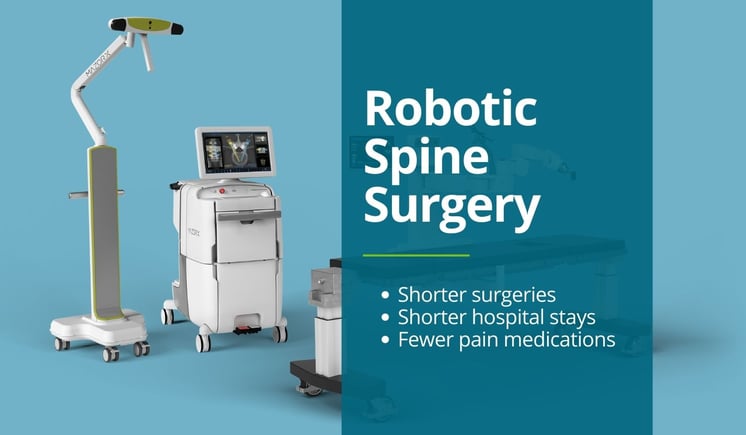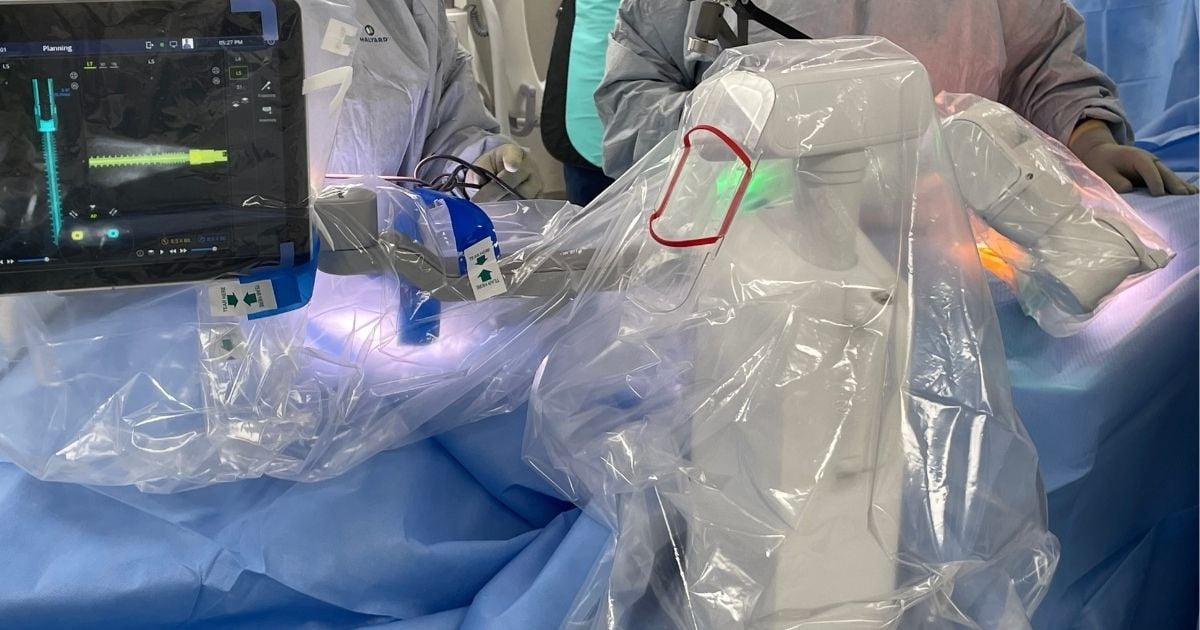
Spine surgery is being revolutionized using robotic technology. Surgery is typically the last option to be considered to eliminate back and neck pain. But, if necessary, these innovative robot-guided systems offer patients many benefits including shorter surgeries, shorter hospital stays, and fewer pain medications. Ask your surgeon if robotic spine surgery is an option to eliminate your back and neck pain.
Read more to find answers to the most frequently asked questions about robotic spine surgery.
What is Robotic Spine Surgery?
Robotic spine surgery, or robot-assisted spine surgery, is a relatively new technology that doesn’t replace the surgeon, but rather, provides robotic assistance during surgery.
Robotic surgery has many potential benefits over traditional “freehand” techniques, including greater accuracy and precision. There are many different types of robotic spine surgery, but all of them involve the use of a robot to help guide the surgeon during the procedure. With robot assisted spine surgery, the surgeon is always in control, the robot's automated arm only provides guidance for the surgeon’s instruments.

What are the Benefits of Robotic Spine Surgery?
Robotic spine surgery has many benefits over traditional spine surgery. For one, patients usually have shorter hospital stays and require less narcotic pain medication.
Some of the other benefits of robotic spine surgery include, but are not limited to:
- Less blood loss – Robot-assisted spine surgery results in less blood loss than traditional spine surgery. This is due to the high precision with which spinal implants can be placed, minimizing damage to surrounding tissues.
- Shorter surgery time – Thanks to the precision of robotic spine surgery, surgery time is often shorter than with traditional spine surgery. This can lead to less pain and swelling for the patient, and a quicker return to normal activities.
- Reduced radiation exposure – One of the biggest benefits of robotic spine surgery is that it results in significantly reduced radiation (x-ray) exposure for the patient. This is due to the high degree of accuracy with which robotic surgery can be performed, minimizing the need for repeated exposures to radiation during surgery.
- Fewer patient complications – Robotic spine surgery can help to minimize patient complications by allowing for more accurate placement of spinal implants. This leads to less damage to surrounding tissues and improved patient safety.
- Reduced need for future surgery – Thanks to the improved accuracy of robotic spine surgery, patients have a lower chance of requiring further surgery in the future. This leads to less pain and improved quality of life for the patient.
- Less time under anesthesia – the reduced operation time also eases the temporary, post-op side effects of anesthesia.
Is Robotic Spine Surgery Better than Traditional Surgery?
Robotic spine surgery offers some clear benefits over traditional surgery. For one, robotic spine surgery is more consistent and reliable, usually resulting in fewer complications and more accurate placement of screws of up to 100% perfect alignment. Additionally, robotic spine surgery generally causes less blood loss and pain than traditional surgery, leading to a quicker and more comfortable recovery. While robotic spine surgery can be more expensive than traditional surgery, the benefits it offers make it a worthwhile investment.
Is Robotic Spine Surgery Safe?
 The first-ever spine robot gained FDA approval in 2004. Industry experts estimate that global robotic-assisted procedure volumes will exceed 30% of total spine surgeries by 2030. As with any surgery, there are risks involved, but robotic spine surgery is one of the safest minimally invasive procedures available. Which is demonstrated by its very low rate of revision (A procedure that can be done to replace or fix an implant that did not work or to fix problems from previous surgery). According to a May 2021 study of 77 patients with 402 screws placed via robotic guidance, none required post-operative replacement. The safety of the robot along with its greater accuracy enables a reduction in surgical time, which can lead to less blood loss, decreased pain, and a quicker recovery.
The first-ever spine robot gained FDA approval in 2004. Industry experts estimate that global robotic-assisted procedure volumes will exceed 30% of total spine surgeries by 2030. As with any surgery, there are risks involved, but robotic spine surgery is one of the safest minimally invasive procedures available. Which is demonstrated by its very low rate of revision (A procedure that can be done to replace or fix an implant that did not work or to fix problems from previous surgery). According to a May 2021 study of 77 patients with 402 screws placed via robotic guidance, none required post-operative replacement. The safety of the robot along with its greater accuracy enables a reduction in surgical time, which can lead to less blood loss, decreased pain, and a quicker recovery.
What are the Disadvantages of Robotic Surgery?
While robotic surgery has many benefits, there are also some disadvantages to consider.
COST
One of the biggest downsides is that it can add to the cost of surgery. The use of high-tech equipment and instruments can, in some cases, increase the cost of surgery and treatment.
AVAILABILITY
Another downside is that robotic surgery is only available at centers of excellence, so not everyone has nearby access to this procedure. They may have to travel multiple hours to reach a facility that has robotic equipment.
RISKS
Finally, there are always risks associated with any surgery, and robotic surgery is no exception. This type of surgery carries the same risks as traditional surgery, such as infection, and blood loss.
So, while robotic surgery has many benefits, there are also some disadvantages to consider. It’s important to weigh the pros and cons before making a decision about whether or not to have robotic surgery. Talk to your doctor to see if it’s the right option for you.
What Conditions can Robotic Spine Surgery Treat?
Robot-guided procedures are used to treat a variety of conditions, including, but not limited to:
- Complex Scoliosis Surgery
- Degenerative Disc Disease
- Herniated Discs (Cervical and Lumbar)
- Compression Fractures
- Back and Neck Implants
- Back and Neck Fusions
- Spondylolisthesis (Cervical and Lumbar)
- Slip or Instability
If you are considering robot-guided spine surgery, be sure to ask your surgeon if it is right for you.
Is Robotic Surgery Right for Me?
Robotic spine surgery may be the right option for you if you are experiencing any of the following conditions: spinal stenosis, degenerative disc disease, spondylolisthesis of the neck or back, scoliosis, or other chronic back or neck pain. Robotic spine surgery is a minimally invasive procedure that uses advanced navigation technology to ensure accurate implant placement.
If you are considering robotic spine surgery, be sure to discuss all your options with your doctor. He or she can help you decide if this is the right procedure for you. Keep in mind that robotic spine surgery is not for everyone, and there may be other treatments that are a better fit for your individual situation.
Watch Thomas's Mazor robotic-assisted spine surgery story.
Who Performs Robotic Spine Surgery in Sioux Falls, SD?
 Matthew K. Wingate, MD - Dr. Wingate specializes in orthopedic spine surgery. He completed his orthopedic surgery residency (five years) and then went on to complete an additional full year of only spine surgery. He is experienced in pediatric and adult spine surgery. Dr. Wingate treats neck and back pain, degenerative disc disease, neck and back arthritis, disc herniations of the neck and back, spinal slip (instability), neck and back fractures, pediatric and adult scoliosis. He received extensive training in the use of the cervical (neck) disc replacement.
Matthew K. Wingate, MD - Dr. Wingate specializes in orthopedic spine surgery. He completed his orthopedic surgery residency (five years) and then went on to complete an additional full year of only spine surgery. He is experienced in pediatric and adult spine surgery. Dr. Wingate treats neck and back pain, degenerative disc disease, neck and back arthritis, disc herniations of the neck and back, spinal slip (instability), neck and back fractures, pediatric and adult scoliosis. He received extensive training in the use of the cervical (neck) disc replacement.

Gregory F. Alvine, MD - Dr. Alvine specializes in minimally invasive and complex spine surgery. He treats neck and back pain, degenerative disc disease, neck and back arthritis, disc herniations of the neck and back, spinal slip (instability), neck and back fractures, pediatric and adult scoliosis.
Dr. Wingate and Dr. Alvine utilize the Mazor X Stealth Edition Robotic Guidance System to provide them with a real-time visualization of the anatomy which enables them to customize the approach to match your specific needs.
Experiencing Joint, Muscle, or Bone Pain or Injury?
Are you experiencing pain in your bones, joints, or muscles? Make an appointment with Orthopedic Institute. Our orthopedic specialists will evaluate your problem and create a personalized care plan for your pain or injury.
Call 605.331.5890 or click below to make an appointment.
Additional articles cited:
- Hyun SJ, Kim KJ, Jahng TA, Kim HJ. Minimally invasive robotic versus open fluoroscopic-guided spinal instrumented fusions. Spine (Phila Pa 1976) 2017;42(6):353–8
- Kim HJ, Jung WI, Chang BS, Lee CK, Kang KT, & Yeom JS. A prospective, randomized, controlled trial of robot‐assisted vs freehand pedicle screw fixation in spine surgery. Int J Med Robotics ComputAssist Surg. 2016 13(3), e1779
- Khan A, Meyers JE, Yavorek S, et al. Comparing Next-Generation Robotic Technology with 3-Dimensional Computed Tomography Navigation Technology for the Insertion of Posterior Pedicle Screws. World Neurosurg 2019; 123, e474-e481.
- Onen MR, Simsek M, & Nader S. Robotic spine surgery: a preliminary report. Turk Neurosurg, 2014 24(4), 512-518.
- Fan Y, Du J, Zhang J, Liu S, Xue X, Huang Y, Zhang J, Hao D. Comparison of Accuracy of Pedicle Screw Insertion Among 4 Guided Technologies in Spine Surgery. Med Sci Monit. 2017 Dec 16;23:5960-5968.


